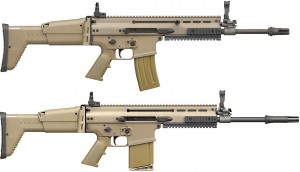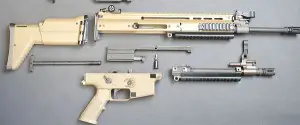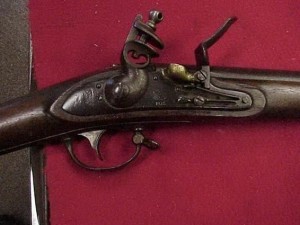 The FN-SCAR was the wave of the future in special operations weapons.
The FN-SCAR was the wave of the future in special operations weapons.
And it’s always gonna be, goes the joke.
What happened? Why didn’t this pretty decent weapon, which was designed to special operations warfighters’ specs and won a bake-off against many competitors, catch on?
Well, it’s not dead yet. Procurement was only halted on the Mk16 aka the SCAR-L (L meaning “Light” — the 5.56 mm version — above left). The military did buy some of them, and a larger quantity of the 7.62mm Mk 17 SCAR-H (H… if you can’t guess you’re too dumb to learn this stuff anyway. Just buy what the fanboys at ARFCOM tell you to). But the SCAR-L was supposed to replace the M4A1 in the special ops world, and it didn’t.
Thing is, the SCAR-L/Mk16 offered only the skinniest of advantages vis-a-vis the plain old M4A1. And it has a few disadvantages. Advantages include excellent ambidextrous ergonomics and a single monolithic high rail, plus 3, 6, and 9 o’clock rails integrated in the design from the beginning. The SCAR-H is a different proposition because none of the other 7.62mm rifles really sit exactly in the battle rifle niche… the closest is probably the M14 EBR, and it’s both heavier than the SCAR-H and showing the age of the underlying design: the M14 dates to the 1950s, and the action traces back to John Garand’s experiments at Springfield Arsenal in the late 1920s. The SR-25 / Mk-11 / M-110 type of AR-15-related 7.62mm rifles that have been procured so far are aimed at the Designated Marksman, or informal sniper, role.
 And the SCAR was swimming upstream against 20-plus years of Special Operations weapons development. (The SOPMOD program has been running since 1989). While the SCAR was designed explicitly for compatibility with existing and projected SOPMOD accessories, one important method of accessorizing AR-based rifles, and one in widespread use in the special operations community, is to snap on a new upper. The most common sM$A1 wap-out is a 10.5″ CQB upper in place of the standard 14.5″ barrel. Sure, the SCAR uppers could have been procured in multiple lengths as the M4 uppers already have been, but what’s the gain in it? The SCAR barrel interchanges, but one advantage of interchanging a whole upper rather than a barrel is that you can leave your optic on the upper, sighted-in. That’s a great convenience — change uppers, fire three rounds to confirm your zero, and you’re good to go.
And the SCAR was swimming upstream against 20-plus years of Special Operations weapons development. (The SOPMOD program has been running since 1989). While the SCAR was designed explicitly for compatibility with existing and projected SOPMOD accessories, one important method of accessorizing AR-based rifles, and one in widespread use in the special operations community, is to snap on a new upper. The most common sM$A1 wap-out is a 10.5″ CQB upper in place of the standard 14.5″ barrel. Sure, the SCAR uppers could have been procured in multiple lengths as the M4 uppers already have been, but what’s the gain in it? The SCAR barrel interchanges, but one advantage of interchanging a whole upper rather than a barrel is that you can leave your optic on the upper, sighted-in. That’s a great convenience — change uppers, fire three rounds to confirm your zero, and you’re good to go.
If you are buying a rifle for yourself, you can decide it’s worth it to you to replace your entire rig, including interchangeable uppers and other modular stuff (we don’t count rail-mountable lights, illuminators and optics, because they interchange on weapons of the same caliber no problem). Something new needs new training, support, maintenance (at all levels from operator to depot) and other expenses. Every arms room needs new racks, which cost Uncle Sam about $40-50 per rifle (they hold ten and cost about $450), and they’re specific to the weapon. Old M14 racks didn’t hold M16s, M16 racks didn’t handle M4s well, and none of them holds a SCAR. That’s one small example of the logistical hurdle to overcome.
If you’re looking for a gun for range trips or home defense, or for a collection, you probably don’t care what it weighs and whether it’s bulky. If your mission profile involves walking 25 miles a day with it or climbing mountains, you probably do. So there’s the bulk objection to overcome.
Now, for civilians whose personal mission requirements can be met by the SCAR, FNH is importing a very nice pair of semiauto SCAR clones. Why they import them while a factory in the USA produces them for the government, we have no idea.
A very important factor that people don’t consider is who pays for the weapons. For SOF, buying SOF-peculiar weapons comes out of SOF money, usually MFP-11 funds as we understand it. Buying weapons, even modified weapons, that are type-standardized by Big Green means you’re spending generic Title 10 Defense budget appropriations. Yeah, we get it: you’re a high-speed low-drag operator and you don’t give a rat’s about some accounting BS. Trust us, colonels and generals, captains and admirals, and their staffs care about this tremendously. The whole war machine runs on dollars, and you young guys will hate serving in it when it’s broke (BTDT, and those days are coming back).
An individual can upgrade a rifle without worrying about most of this stuff. His gun safe will hold the SCAR as well as it would hold an M1A, he can put the old rifle on GunBroker to pay for the new one — not an option for Uncle (probably should be, but that’s politics and we don’t cover that here). Or he can buy both (which is what SOF are doing with the SCARs they do buy, running them along with M4s instead of replacing the Colt carbines). But a whole Army has other considerations.
 Now, obviously, this does not mean a superior new technology can’t replace an old one. Or we’d still be toting ’16s: M1816 Springfield flintlock muskets. But it either has to be very markedly superior, or come along at just the right time when the old technology weapon is worn out. If a weapon misses its window, it usually never gets a second chance. (A rare exception was the FN-MAG machine gun. Rejected by the US military in favor of the “invented-here” M60, it wound up replacing the M60 as the M240 about four decades later). But people also wonder why the USA did not adopt the M1941 Johnson, the FN-FAL, the AR-18: they may have had some advantages over the incumbent weapons systems, but not enough to justify the costs. In most cases, they had some disadvantages too.
Now, obviously, this does not mean a superior new technology can’t replace an old one. Or we’d still be toting ’16s: M1816 Springfield flintlock muskets. But it either has to be very markedly superior, or come along at just the right time when the old technology weapon is worn out. If a weapon misses its window, it usually never gets a second chance. (A rare exception was the FN-MAG machine gun. Rejected by the US military in favor of the “invented-here” M60, it wound up replacing the M60 as the M240 about four decades later). But people also wonder why the USA did not adopt the M1941 Johnson, the FN-FAL, the AR-18: they may have had some advantages over the incumbent weapons systems, but not enough to justify the costs. In most cases, they had some disadvantages too.
(Image credits: Mk-16 and -17, FNH via Wikimedia Commons; Disassembled Mk-16,C. Rohling via C. Cutshaw and world.guns.ru; M1816, snagged from a GunBroker auction).

Kevin was a former Special Forces weapons man (MOS 18B, before the 18 series, 11B with Skill Qualification Indicator of S). His focus was on weapons: their history, effects and employment. He started WeaponsMan.com in 2011 and operated it until he passed away in 2017. His work is being preserved here at the request of his family.
